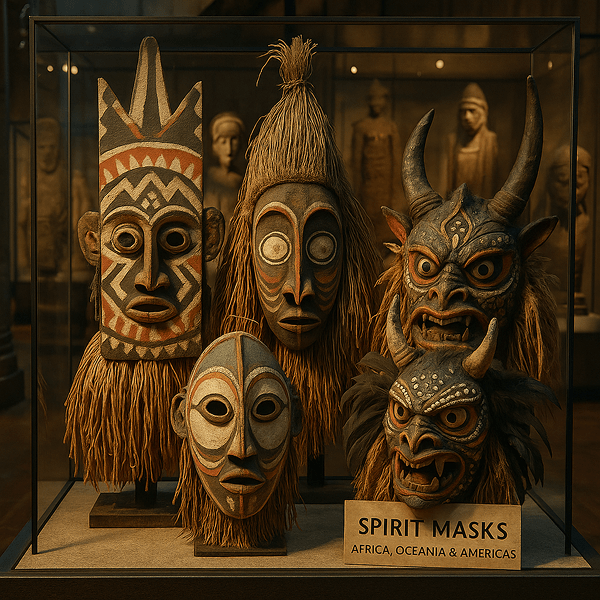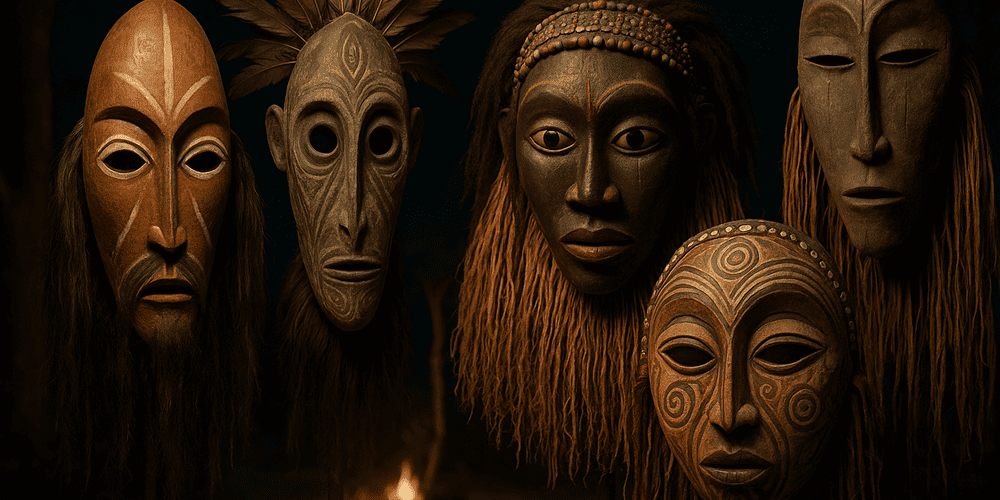Ritual Spirit Masks are among the most evocative and powerful artifacts in the world’s sacred traditions. Crafted to embody, channel, or appease spiritual entities, these masks are used in ceremonies that bridge the human and supernatural realms. Visually, Spirit Masks are highly distinctive: they may feature elongated or exaggerated facial features, abstract or otherworldly designs, dramatic eyes, and intricate decorations with feathers, shells, raffia, beads, or animal hair. Many are painted with symbolic patterns or colored with natural pigments, creating an aura of mystery and reverence. Spirit Masks are especially prominent in sub-Saharan Africa, Melanesia, Oceania, the Americas, and Arctic regions, with each culture contributing its own unique iconography and ritual function. Their origins in ritual practice stretch back thousands of years and remain vital in many communities today.
Historical Origins of Ritual Spirit Masks
The history of Spirit Masks is deeply intertwined with the development of animistic and shamanistic belief systems. The term “spirit mask” broadly refers to a mask used to represent or embody supernatural forces — ancestral spirits, deities, nature beings, or powerful ghosts. The English word “spirit” derives from the Latin “spiritus,” meaning “breath” or “life force,” highlighting the connection between mask and soul. Archaeological evidence shows that masks were used in prehistoric burial sites, sacred caves, and ceremonial complexes, suggesting a long-standing role in mediating with the unseen world. Over centuries, the design and function of Spirit Masks have evolved in response to religious shifts, cultural exchange, and social change. In Africa, masks associated with secret societies such as the Egungun (Yoruba) or Bwa (Burkina Faso) are central to ancestor worship and community protection. In Melanesia and Papua New Guinea, spirit masks are used in initiation rites, healing ceremonies, and rituals for the dead. Throughout their evolution, Spirit Masks have absorbed local myths, artistic styles, and sacred materials, resulting in a stunning diversity of forms and meanings. The tradition of Initiation Masks is closely related, as both serve to mark transitions and connect with powerful unseen forces.
Cultural Significance and Symbolism of Spirit Masks
Spirit Masks hold deep cultural and spiritual meaning in their native societies. They are believed to allow the wearer — or sometimes the mask itself — to become a vessel for the presence of a spirit, ancestor, or deity. This transformation is at the heart of ritual: the mask wearer may speak with the voice of the spirit, perform sacred dances, or deliver oracles and blessings. The mask’s features — enlarged eyes, animal horns, sharp teeth, or abstract forms — often symbolize the particular qualities or domains of the spirit, such as fertility, wisdom, power, or protection. Myths and legends frequently recount the origins of specific masks and their miraculous powers, from bringing rain or healing sickness to protecting the village from evil. Socially, Spirit Masks are used to reinforce community values, transmit oral traditions, and enact moral lessons. The religious aspect is paramount: masks serve as mediators between the living and the dead, the earthly and the divine, ensuring harmony and spiritual well-being.

Materials and Craft Techniques of Spirit Masks
The creation of Ritual Spirit Masks is a highly respected and often sacred task. Traditional masks are carved from local hardwoods, but may also be made from bark, woven fiber, clay, leather, bone, or shells. Artisans employ a range of tools — knives, chisels, adzes, and sometimes fire — to shape and hollow the mask. Decoration is elaborate and symbolic: natural pigments (red ochre, white kaolin, black charcoal), beads, cowrie shells, feathers, raffia, and animal hair are applied with great care. Special techniques such as inlay, burning, or scarification may enhance the mask’s spiritual potency. Each region has its own stylistic conventions: Northwest Coast Native American spirit masks are often articulated and painted with totemic motifs, while African spirit masks may be adorned with animal horns, teeth, or mirrors. Color symbolism is crucial — red for life force or danger, white for purity or ancestral spirits, black for the unknown or protection. Special rituals often accompany the mask’s creation to imbue it with spiritual energy before it is used in ceremony.
Functions and Uses of Spirit Masks
Spirit Masks have a wide range of ritual and ceremonial functions. In many societies, they are worn by shamans, priests, or designated community members during ceremonies for healing, protection, rainmaking, harvest, or funerals. The mask’s power is believed to flow from the spirit it represents, enabling the wearer to perform feats of prophecy, exorcism, or blessing. In festivals and public celebrations, Spirit Masks may be used in dances, processions, or dramatic reenactments of mythic events, engaging the entire community in the ritual. In some cultures, masks are also used in judicial or social control contexts, where the spirit’s authority is invoked to enforce taboos or resolve disputes. Over time, the use of Spirit Masks has adapted to new contexts — today, they appear in cultural exhibitions, contemporary performances, and as symbols of identity and resistance. Their enduring presence attests to their ongoing spiritual and social relevance.
Regional Variations of Spirit Masks
Spirit Masks exhibit remarkable regional and cultural diversity. In West and Central Africa, masks such as the Yoruba Egungun, Dogon Kanaga, and Bwa plank masks are central to ancestor cults and seasonal rituals. In Melanesia and Papua New Guinea, spirit masks are often used in initiation, mortuary, and healing ceremonies, with each clan or village developing unique forms and motifs. Arctic peoples, such as the Inuit, create spirit masks from driftwood, bone, and fur, often with movable parts to represent animal transformations. Native American traditions feature spirit masks used in healing, rainmaking, and social rituals. Each region’s masks are shaped by local myths, cosmology, and social organization, yet all share the goal of mediating with the spirit world. Comparisons with other ritual masks reveal both shared symbols and unique artistic traditions.
Famous Examples and Collections of Spirit Masks
Some of the world’s most renowned Spirit Masks are preserved in museums and private collections. The Musée du Quai Branly (Paris), the British Museum (London), and the Smithsonian National Museum of the American Indian (Washington, D.C.) all house significant collections of spirit masks from Africa, Oceania, and the Americas. Notable artifacts include the Bwa plank masks of Burkina Faso, the Yup’ik transformation masks of Alaska, and the Malagan masks of New Ireland. Important archaeological finds and early ethnographic collections provide insight into the history and evolution of these masks. Online platforms and virtual galleries, such as toddmasks.com, offer high-resolution images and expert commentary, making Spirit Masks accessible to a global audience.

Influence of Spirit Masks on Art and Culture
Spirit Masks have had a lasting impact on world art, literature, and performance. Their bold forms and symbolic power have inspired painters, sculptors, and filmmakers — most notably in the works of Pablo Picasso, André Derain, and contemporary indigenous artists. In literature and cinema, spirit masks often symbolize transformation, hidden truth, or the passage between worlds. Modern designers incorporate mask motifs in fashion, jewelry, and stage design, blending tradition with innovation. The preservation and reinterpretation of spirit mask traditions play a vital role in cultural education, heritage conservation, and creative expression, both within source communities and the wider world.
Contemporary Status and Preservation of Spirit Mask Traditions
Today, Ritual Spirit Masks are both preserved and adapted by master artisans, communities, and cultural organizations. Traditional carving, painting, and ceremonial techniques are taught in workshops, festivals, and masterclasses, while contemporary artists experiment with new materials and digital media. Museums, universities, and online resources — such as toddmasks.com — provide research, documentation, and public engagement, ensuring that the knowledge and appreciation of spirit masks endure. Community-based projects and educational programs help sustain living traditions, while ethical collecting and documentation safeguard spiritual and cultural values for future generations.
Collecting and Acquiring Spirit Masks
The market for Spirit Masks is varied, with authentic ritual pieces, high-quality replicas, and modern interpretations available from artisans, galleries, museums, and online platforms. Prices depend on age, craftsmanship, provenance, and cultural significance. Collectors are encouraged to seek expert advice, verify authenticity, and prioritize ethical sources that support local artists and communities. Toddmasks.com provides expert guidance on collecting, authentication, and ethical considerations. Responsible collecting helps ensure that masks are respected as cultural treasures, supporting heritage preservation and community well-being.
